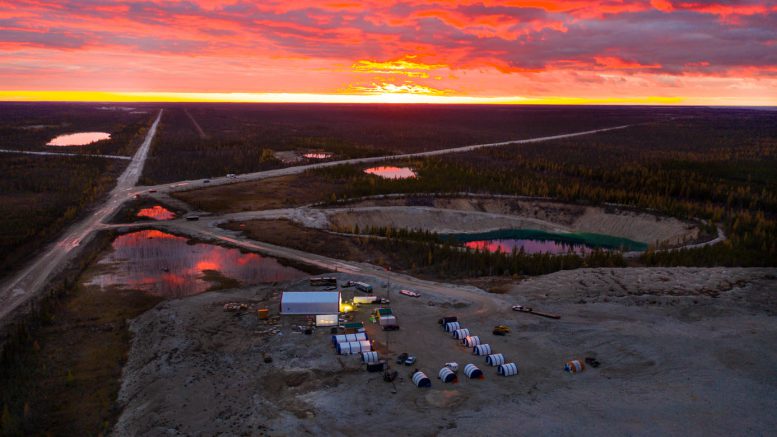Osisko Metals (TSX: OM; US-OTC: OMZNF) is part of a rising trend tapping private equity to help build projects, but it’s wary of the growing role of “predatory” debt financing.
Appian Capital Advisory, a London-based private equity firm with mining projects valued at US$3.6 billion, is investing $25 million for a quarter of Osisko’s Pine Point zinc-lead mine in the Northwest Territories.
Appian is to hold 60% of the project after spending $100 million as it covers costs until a final investment decision, Osisko chairman and CEO Robert Wares told The Northern Miner in an interview in New York this month at the Society for Mining, Metallurgy & Exploration’s eighth annual Trends in Mining Finance Conference.
“As a business model for a junior developer, quite honestly, I could do this repeatedly. Find good projects, drill them off, define a significant resource and private equity groups like Appian are often willing to step in,” Wares said. “If we retain 40-50% free carried to mine build, what’s wrong with that? If I do that multiple times, I’m still building great value for shareholders and we’ve got partners who are going to finance the mine and spare shareholders excessive dilution.”
Osisko Metals, part of a group of companies including Osisko Gold Royalties (TSX: OR; NYSE: OR), Osisko Mining (TSX: OSK) and Osisko Development (TSXV: ODV; NYSE: ODV) started by the same team that developed the Canadian Malartic gold mine, now the country’s largest, is embracing private equity as a solution for junior base metals companies that may not earn enough support from equity markets.
Private equity investing in Canadian mining companies was just $44 million last year out of $10 billion across all industries, according to the Canadian Venture Capital and Private Equity Association. But asset managers such as New York-based Orion Resource Partners with US$8 billion under management and pension funds like the Ontario Teachers with $247 billion in assets are increasingly structuring deals like private equity with dominant lender status, loans convertible to equity stakes and double-digit returns targeted.
Last year Orion invested US$275 million in Sabina Gold & Silver (TSX: SBB; US-OTC: SGSVF), which was recently bought by B2Gold (TSX: BTO; NYSE: BTG), and the pension fund is pitching in $200 million for Foran Mining’s (TSXV: FOM; US-OTC: FMCXF) McIlvenna Bay copper project in Saskatchewan.
Osisko’s other main investment is the Gaspé copper project in Quebec which it’s buying from Glencore (LSE: GLEN) in a deal expected to close next month. It’s another past-producing site with power lines and roads, plus access to a deep water port compared with a railway near Pine Point. Drilling up to 10,000 metres this year at both sites is continuing with feasibility studies due on each by the end of next year, Wares said.
Pine Point boasted a town of 2,000 people on the south shore of Great Slave Lake about 90 km east of Hay River when Cominco, now part of Teck Resources (TSX: TECK.A/TECK.B; NYSE: TECK), mined about 10 million tonnes of lead and zinc from 1965 to 1988. The mine closed and the town was dismantled after zinc prices fell.
Osisko bought the property in 2018 and last year’s preliminary economic assessment shows the project has a net present value of $602 million at an 8% discount rate with a 25% internal rate of return. Pine Point is expected to produce 329 million lb. zinc and 141 million lb. lead annually over 12 years. Total revenue after a royalty is forecast at $5.6 billion.
Pre-production spending is estimated at $653 million. Wares figures Osisko’s share will be about $280 million, but raising the cash from sales of new shares would be too dilutive because the market’s valuations of base metals projects are too low, he said. However, he’s finding debt financiers want the whole project as collateral when he just wants to borrow smaller amounts to start production.
“I’m not going to offer the whole project as a guarantee for $30 to $50 million. That’s absurd. I’ve been through this three times now,” he said. “These debt deals are predatory and they put your entire project at risk. If you sign off on that you’re desperate.”
Earlier debt
The battery metals surge of interest in mining has seen debt financiers increasingly offering to fund projects as early as feasibility studies when they used to wait for permits, Wares said. Juniors need to ensure the agreements prevent stock dilution, he said.
With brownfield sites comes the risk of inheriting environmental problems. Wares says the province has told him responsibility for some zinc and lead contamination of a former rail line at Pine Point lies with Teck and the government. He says he’s had experience with cleanups, such as Barrick Gold’s (TSX: ABX; NYSE: GOLD) legacy at Canadian Malarctic.
“The tailings ponds were acid-generating, so we integrated remediation into our disposal,” he said. “You’d be surprised, but on brownfield sites whatever additional remediation needs to be done can often be integrated into your mine plan, and that’s the best way you get your permit.”
At Gaspé, Noranda produced 150 million tonnes of copper concentrate from 1955 until the mine closed in 1999. The population of Murdochville fell to 600 from 3,000 but a new generation is now concerned their outdoor lifestyle could be threatened by a revived mine, Wares said. Osisko, wary of professional mining opponents flooding the community with misinformation, immediately said there would be five years of studies before any potential mining.
“Now they feel there’s time for discussion, planning, transparency and coming up with a plan that’s going to incorporate the community and everyone’s concerns,” he said. “The best way to fight NIMBYism is to be transparent and nip it in the bud before it becomes a problem.”


Be the first to comment on "Osisko cofounder Wares praises private equity, scolds debt financiers, nips NIMBYism"